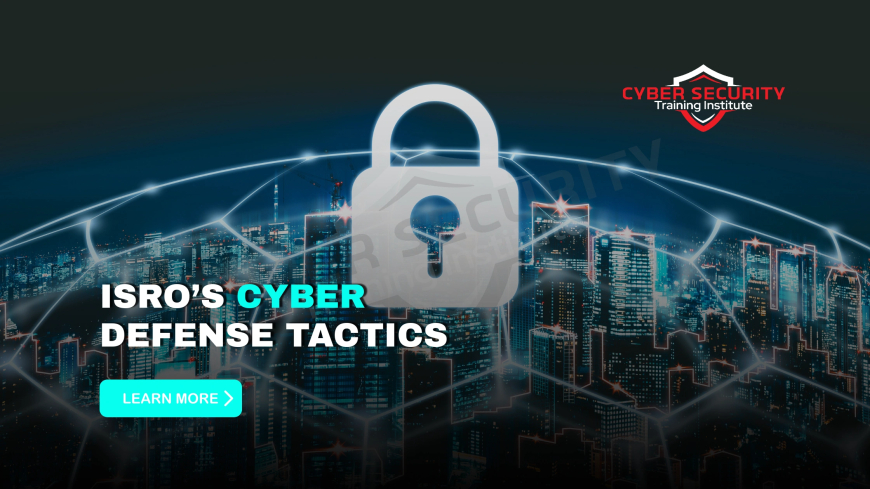Cyber Defense Strategies for the Indian Space Research Organisation (ISRO)
The Indian Space Research Organisation (ISRO) is a global leader in space exploration, launching satellites, and advancing scientific research. However, as ISRO pushes the boundaries of space technology, it faces an equally critical challenge: protecting its digital infrastructure from cyber threats. In an era where cyberattacks are becoming more sophisticated, safeguarding ISRO’s sensitive data, mission-critical systems, and intellectual property is paramount. From satellite communication networks to ground control systems, every component of ISRO’s operations is a potential target for cybercriminals, state-sponsored hackers, or even insider threats. This blog post explores practical and effective cyber defense strategies tailored for ISRO, ensuring its missions remain secure in the digital age.

Table of Contents
- Why Cyber Defense Matters for ISRO
- Key Cyber Threats Facing ISRO
- Core Cyber Defense Strategies for ISRO
- Implementing Cyber Defense at ISRO
- Challenges in Securing ISRO’s Systems
- Case Studies of Cyber Defense in Space Agencies
- Conclusion
- Frequently Asked Questions
Why Cyber Defense Matters for ISRO
ISRO’s contributions to space exploration, such as the Chandrayaan and Mangalyaan missions, rely heavily on advanced technology and interconnected systems. These systems handle vast amounts of sensitive data, including satellite telemetry, mission plans, and proprietary research. A single cyber breach could disrupt a mission, compromise national security, or result in the loss of billions of rupees. Cyber defense is not just about protecting data but also ensuring the reliability of satellite launches, ground operations, and international collaborations. A robust cybersecurity framework is essential to maintain public trust, safeguard India’s space ambitions, and protect critical infrastructure from adversaries.
Key Cyber Threats Facing ISRO
ISRO operates in a complex digital environment, making it vulnerable to various cyber threats. Below are the primary risks:
- Phishing Attacks: Hackers may send fraudulent emails to ISRO employees, tricking them into revealing login credentials or installing malware.
- Malware and Ransomware: Malicious software can infiltrate systems, steal data, or lock critical files until a ransom is paid.
- Distributed Denial of Service (DDoS) Attacks: Overwhelming ISRO’s servers with traffic can disrupt mission operations or communication with satellites.
- Insider Threats: Disgruntled employees or contractors with access to sensitive systems could intentionally or unintentionally cause harm.
- State-Sponsored Attacks: Foreign actors may target ISRO to steal intellectual property or sabotage missions for geopolitical reasons.
- Supply Chain Attacks: Compromised third-party vendors or software providers could introduce vulnerabilities into ISRO’s systems.
Core Cyber Defense Strategies for ISRO
To counter these threats, ISRO must adopt a multi-layered cybersecurity approach. Below are key strategies tailored to its unique needs:
| Strategy | Description | Benefit |
|---|---|---|
| Network Segmentation | Divide ISRO’s network into isolated segments to limit the spread of cyberattacks. | Reduces the impact of a breach by containing it to a single segment. |
| Zero Trust Architecture | Require continuous verification for every user and device accessing ISRO’s systems. | Prevents unauthorized access, even from trusted insiders. |
| Encryption | Use strong encryption for data transmission between satellites, ground stations, and servers. | Protects sensitive data from interception by hackers. |
| Regular Penetration Testing | Simulate cyberattacks to identify and fix vulnerabilities in ISRO’s systems. | Proactively strengthens defenses before real attacks occur. |
| Employee Training | Educate staff on recognizing phishing emails and following cybersecurity best practices. | Reduces human errors, a common entry point for cyberattacks. |
Implementing Cyber Defense at ISRO
Implementing these strategies requires careful planning and coordination. Here’s how ISRO can put them into action:
- Develop a Cybersecurity Policy: Create a comprehensive policy outlining roles, responsibilities, and protocols for handling cyber threats.
- Invest in Technology: Deploy advanced firewalls, intrusion detection systems, and endpoint protection tools to monitor and secure ISRO’s infrastructure.
- Collaborate with Experts: Partner with cybersecurity firms and government agencies like CERT-In to stay updated on emerging threats.
- Incident Response Plan: Establish a clear plan for detecting, responding to, and recovering from cyber incidents to minimize damage.
- Secure Satellite Communications: Use quantum cryptography or other advanced methods to protect data transmitted between satellites and ground stations.
- Regular Audits: Conduct periodic audits of software, hardware, and third-party vendors to ensure compliance with security standards.
By integrating these measures, ISRO can create a robust defense system that evolves with the threat landscape.
Challenges in Securing ISRO’s Systems
Despite the importance of cybersecurity, ISRO faces several challenges:
- Legacy Systems: Older systems may lack modern security features, making them vulnerable to attacks.
- Resource Constraints: Budget and manpower limitations can hinder the adoption of advanced cybersecurity tools.
- Global Supply Chain: Dependence on international vendors for hardware and software introduces risks of compromised components.
- Rapidly Evolving Threats: Hackers continuously develop new techniques, requiring ISRO to stay ahead of the curve.
- Balancing Security and Accessibility: Overly strict security measures could slow down mission-critical operations.
Addressing these challenges requires a balance of technology, policy, and collaboration to ensure ISRO’s systems remain secure without compromising efficiency.
Case Studies of Cyber Defense in Space Agencies
Learning from other space agencies can provide valuable insights for ISRO. Here are two examples:
- NASA’s Cybersecurity Framework: NASA employs a layered security approach, including encryption, regular audits, and employee training. In 2019, NASA successfully mitigated a ransomware attack by isolating affected systems and restoring backups, demonstrating the importance of a strong incident response plan.
- ESA’s Zero Trust Implementation: The European Space Agency (ESA) adopted a zero-trust model, requiring continuous authentication for all users. This approach helped prevent unauthorized access during a 2021 phishing campaign targeting its satellite operations.
ISRO can adapt these lessons by investing in similar frameworks while tailoring them to its unique operational needs.
Conclusion
As ISRO continues to achieve milestones in space exploration, the importance of cybersecurity cannot be overstated. From phishing attacks to state-sponsored hacking, the threats facing ISRO are diverse and evolving. By adopting strategies like network segmentation, zero-trust architecture, encryption, and employee training, ISRO can protect its critical systems and data. Implementing these measures requires investment, collaboration, and a proactive mindset to stay ahead of cybercriminals. While challenges like legacy systems and resource constraints exist, learning from global space agencies and leveraging cutting-edge technologies can help ISRO build a resilient cyber defense framework. Ultimately, a secure digital infrastructure will ensure that ISRO’s missions soar to new heights without being grounded by cyber threats.
Frequently Asked Questions
What is cybersecurity in the context of ISRO?
Cybersecurity for ISRO involves protecting its digital systems, satellite networks, and data from unauthorized access, attacks, or disruptions.
Why is ISRO a target for cyberattacks?
ISRO’s critical role in space exploration and national security makes it a prime target for hackers seeking to steal data or disrupt missions.
What is a phishing attack?
A phishing attack involves cybercriminals sending fake emails or messages to trick users into sharing sensitive information or downloading malware.
How can ISRO prevent phishing attacks?
ISRO can prevent phishing by training employees to recognize suspicious emails and using email filters to block malicious messages.
What is network segmentation?
Network segmentation divides a network into smaller, isolated parts to limit the spread of a cyberattack.
Why is encryption important for ISRO?
Encryption protects data transmitted between satellites and ground stations, ensuring it cannot be intercepted or altered by hackers.
What is a zero-trust architecture?
Zero-trust architecture requires continuous verification of every user and device, preventing unauthorized access to systems.
How does malware affect ISRO’s operations?
Malware can steal data, disrupt satellite communications, or lock critical systems, potentially delaying or compromising missions.
What is a DDoS attack?
A DDoS attack floods servers with traffic to overwhelm them, disrupting ISRO’s ability to control satellites or process data.
How can ISRO prepare for insider threats?
ISRO can monitor user activity, restrict access to sensitive systems, and conduct background checks to mitigate insider threats.
What role does employee training play in cybersecurity?
Training helps employees recognize threats like phishing and follow best practices, reducing the risk of human error.
Can legacy systems be secured?
Yes, legacy systems can be secured by updating software, isolating them from the internet, or replacing them with modern alternatives.
What is penetration testing?
Penetration testing involves simulating cyberattacks to identify and fix vulnerabilities in ISRO’s systems before hackers exploit them.
How can ISRO collaborate with other agencies?
ISRO can work with CERT-In, cybersecurity firms, and global space agencies to share threat intelligence and best practices.
What is an incident response plan?
An incident response plan outlines steps to detect, contain, and recover from cyberattacks to minimize damage.
Why are supply chain attacks a concern for ISRO?
Compromised vendors or software can introduce vulnerabilities, allowing hackers to infiltrate ISRO’s systems.
How does quantum cryptography help ISRO?
Quantum cryptography uses advanced physics to secure satellite communications, making them nearly impossible to hack.
What lessons can ISRO learn from NASA?
ISRO can adopt NASA’s layered security approach, including encryption, backups, and rapid incident response.
How does ESA’s zero-trust model benefit ISRO?
ESA’s model shows how continuous authentication can prevent unauthorized access, which ISRO can implement for its systems.
What is the future of cybersecurity for ISRO?
The future involves adopting AI-driven threat detection, quantum security, and global collaborations to stay ahead of cyber threats.
What's Your Reaction?
 Like
0
Like
0
 Dislike
0
Dislike
0
 Love
0
Love
0
 Funny
0
Funny
0
 Angry
0
Angry
0
 Sad
0
Sad
0
 Wow
0
Wow
0
















